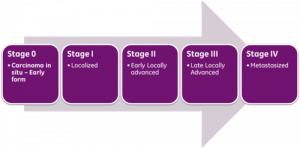
What is Cancer Staging?
-
My patients often ask, “What is the stage of my cancer?"
If they don’t ask me, I typically tell them their cancer’s stage and it’s usually on my mind. Why is the stage important?
The amount of cancer in a patient’s body, and where it is located (or how far it has spread) determines the cancer’s stage. Once the “staging” has been completed, it is possible for doctors to prepare treatment plans and to make some predictions about how likely it is that the treatment will control the cancer. This can be done because, although every patient is different, there are common threads. Based upon results of treating other patients with the same kind and stage of cancer, specialists have a better chance to foretell how the cancer will behave—how it will respond to treatment, and whether it is likely to come back after treatment or not.
Today, most cancers are staged according to the TNM system, which considers the size of the original tumor, whether it has spread to lymph nodes, and whether it has spread through the bloodstream.
Why We Stage Cancers
Staging a cancer allows doctors to compare treatment results from one patient to another, to compare different types of treatment for a particular type and stage of cancer, and to compare results between different centers. As a result, cancer specialists can use staging information as a sort of “shorthand” to communicate with one another about a patient and that patient’s cancer.
Modern cancer treatment usually depends upon where the tumor is, and whether it has begun to spread. Therefore, all members of the patient’s team should know the stage (or understand how the next steps will give more information about the stage) before patients start treatment.
That’s why people with cancer (and their doctors) should know the stage. You should seldom start treatment without it.
